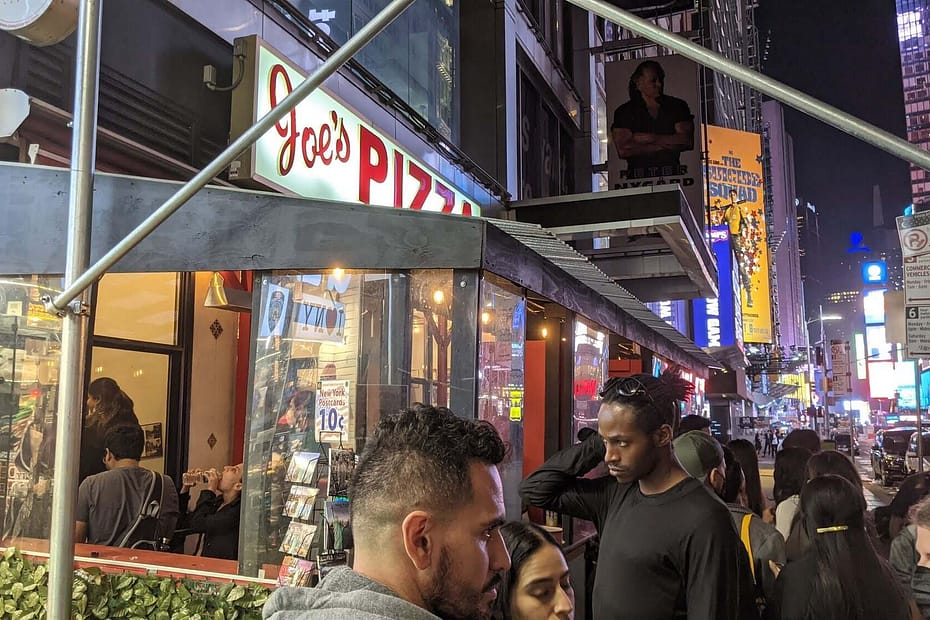Joe’s Pizza is a New York City classic! Whether you believe in the hype or not, for anyone visiting NYC looking for a good pizza, they’d undoubtedly happen upon Joe’s Pizza on the interwebs.
For me and a couple of friends, after having been turned away from a Dosa stop that was closing early, Joe’s was the obvious choice! We’d never had it before and 11 pm seemed like a perfect time as any to go try the famous marinara-covered-dough.
Of course, for anything with rave reviews in NYC, having to wait in a line is a given. But this line had an annoyance on par with some of the worst airport security checks. But at least on the other side of the line was pizza!
After 30 minutes of the line only having moved a few feet, I decided to scout the line at another nearby pizza place. The name of the place wasn’t too memorable but it had a line out the door as well (but perhaps not as long). Inevitably we decided on just waiting for Joe’s, which at least had the reputation behind it so maybe waiting in the line was worthwhile?
But what if the line for the other pizza place had been longer? Would that have made us want to switch? If we didn’t know about Joe’s pizza in that case, would the length of the line indicate the quality of the pizza?
Maybe the other pizza place should just become less optimal, making people wait longer, creating a false sense of desirability.
Queues, specifically for non-essential goods and services have some bizarre qualities when it comes to people’s psychology. How do we choose what queue to join, when we don’t have any information? And how can we make the most out of that limited information to maximize our potential gain.
The meaning behind lines
1. 🤩 this is probably really popular
Often visiting new places, I try to utilize online reviews when figuring what to do and where to eat. Sure, it helps get a better sense of the options, but when we have limited information, queues become a beacon. We think others know something that we don’t and trust that not everyone could be wrong! Even if the restaurant right next door, selling the same good, might have a much smaller line, we treat the line as an indicator of quality.
2. A symbol of inefficiency
Of course, it might just be that one of the locations is very inefficient in how it processes customers. Take a grocery store for example. A longer line with one cashier likely won’t mean that people believe the service of the cashier is great. It’s either the customers have too many items, or the cashier is probably a tad bit slow.
3. A test of our desire for the product
That night when we were in line for dinner, we didn’t just want any pizza, we wanted Joe’s Pizza. There was a tradeoff we could have made, lose the experience of “Joe” and just eat at a different pizza place. But the value we placed on the experience outweighed the value of the time, at least at that queue size.
4. Brand alignment and exclusivity 📱
For some products, the queue length can become a symbol of their brand. If you have ever been to Trader Joe’s, you know what I am talking about. The long single queue that snakes along the aisles. It might be more efficient but the queue is purposely built to provide an experience for customers. But that queue has nothing on Apple telling the world a new phone is coming out. Your identity is further aligned with the Apple brand when you indicate your willingness to stand for hours in line for it.
So what? Why do I care?
It’s perfectly fine to wait in lines, and sometimes, those lines are essential to the experience! If there were no lines at an amusement park, I’m not sure if there would be as much anticipation built up for the ride as there is with lines.
But that also means lines have a way of changing behavior, and that’s where we need to figure out what that behavior is, as well as if it aligns with what we actually want to do.
Although the line for Joe’s Pizza was expected, it changed how many slices of pizza I wanted. Ideally, if my hunger levels hadn’t changed, I should have still eaten too. But the wait made it necessary to get the third slice, to make the wait worth it. That time was a sunk cost, I wasn’t getting it back either way. But my purchasing behavior changed from having waited in line.
My college used to have buffet-style cafeterias, and during peak hours, the line would be unbearable. If you did have to eat at that time, once you got to the front of the line, you would grab as much as you could, even if it meant not eating everything, just so you wouldn’t have to wait again.
Chances are, you will encounter lines in your life that are probably methodically engineered to ensure just enough efficiency that you’re likely to stay, but also just long enough that it might change some behavior associated with the product or service. They may also just occur naturally, as information cascades propagating the belief of the product at the end of the line, from one person to the next.
With that said, it’s also possible to be aware of these situations and critically analyze the line’s influence on our decisions. Asking questions about what you actually want, and whether the queue’s influence aligns with that, is an easy way to determine if it’s worth it.
